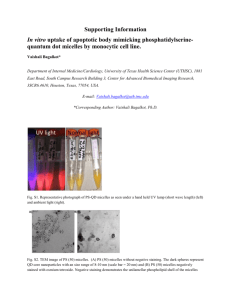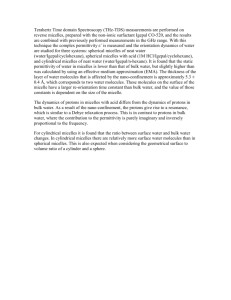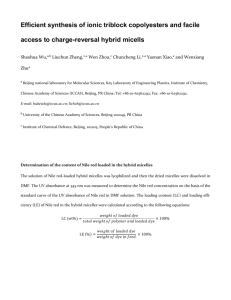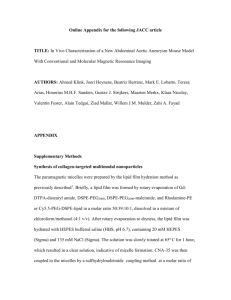(ramp 3 °C/min) and the mixture was decomposed for 110 min with a
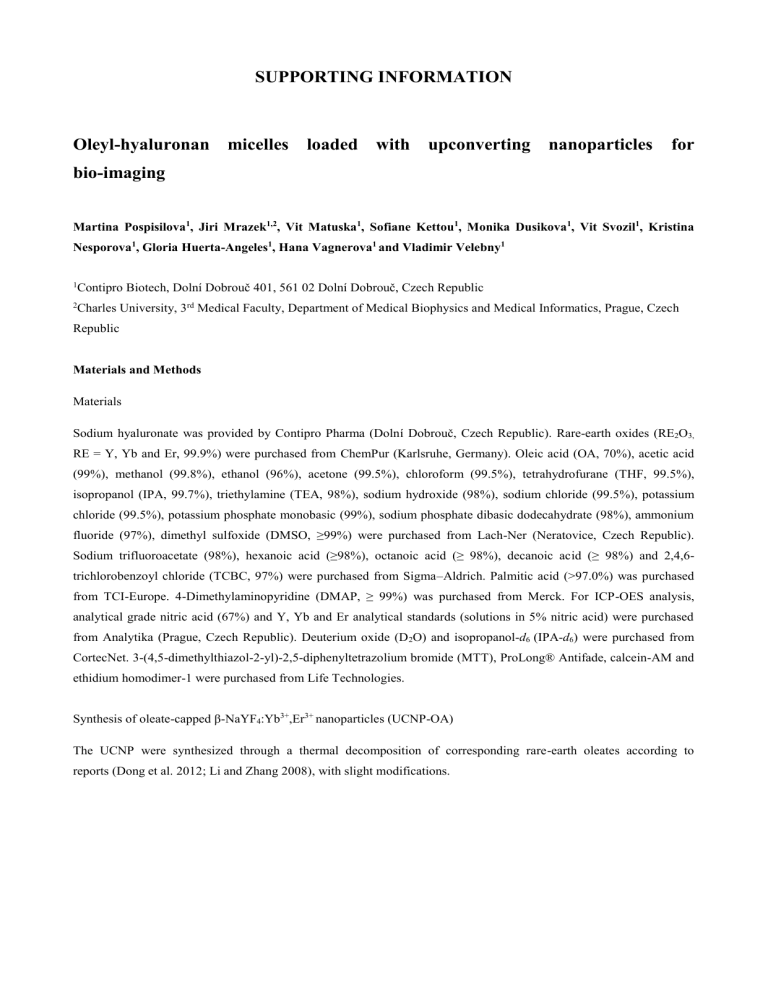
SUPPORTING INFORMATION
Oleyl-hyaluronan micelles loaded with upconverting nanoparticles for bio-imaging
Martina Pospisilova 1 , Jiri Mrazek 1,2 , Vit Matuska 1 , Sofiane Kettou 1 , Monika Dusikova 1 , Vit Svozil 1 , Kristina
Nesporova 1 , Gloria Huerta-Angeles 1 , Hana Vagnerova 1 and Vladimir Velebny 1
1 Contipro Biotech, Dolní Dobrouč 401, 561 02 Dolní Dobrouč, Czech Republic
2 Charles University, 3 rd Medical Faculty, Department of Medical Biophysics and Medical Informatics, Prague, Czech
Republic
Materials and Methods
Materials
Sodium hyaluronate was provided by Contipro Pharma (Dolní Dobrouč, Czech Republic). Rare-earth oxides (RE
2
O
3,
RE = Y, Yb and Er, 99.9%) were purchased from ChemPur (Karlsruhe, Germany). Oleic acid (OA, 70%), acetic acid
(99%), methanol (99.8%), ethanol (96%), acetone (99.5%), chloroform (99.5%), tetrahydrofurane (THF, 99.5%), isopropanol (IPA, 99.7%), triethylamine (TEA, 98%), sodium hydroxide (98%), sodium chloride (99.5%), potassium chloride (99.5%), potassium phosphate monobasic (99%), sodium phosphate dibasic dodecahydrate (98%), ammonium fluoride (97%), dimethyl sulfoxide (DMSO, ≥99%) were purchased from Lach-Ner (Neratovice, Czech Republic).
Sodium trifluoroacetate (98%), hexanoic acid (≥98%), octanoic acid (≥ 98%), decanoic acid (≥ 98%) and 2,4,6trichlorobenzoyl chloride (TCBC, 97%) were purchased from Sigma–Aldrich. Palmitic acid (>97.0%) was purchased from TCI-Europe. 4-Dimethylaminopyridine (DMAP, ≥ 99%) was purchased from Merck. For ICP-OES analysis, analytical grade nitric acid (67%) and Y, Yb and Er analytical standards (solutions in 5% nitric acid) were purchased from Analytika (Prague, Czech Republic). Deuterium oxide (D
2
O) and isopropanold
6
(IPAd
6
) were purchased from
CortecNet. 3-(4,5-dimethylthiazol-2-yl)-2,5-diphenyltetrazolium bromide (MTT), ProLong® Antifade, calcein-AM and ethidium homodimer-1 were purchased from Life Technologies.
Synthesis of oleate-capped β-NaYF
4
:Yb 3+ ,Er 3+ nanoparticles (UCNP-OA)
The UCNP were synthesized through a thermal decomposition of corresponding rare-earth oleates according to reports (Dong et al. 2012; Li and Zhang 2008), with slight modifications.
Preparation of rare-earth acetates (RE(OAc)
3
)
RE(OAc)
3
stock solutions (0.04M, RE = Y, Yb and Er) were prepared separately for each RE 3+ as follows. RE
2
O
3 was added in slight excess to 30% acetic acid under mild stirring. The suspension was gently refluxed for 1 h (oil bath temperature 125 - 130 ºC). If the suspension did not clear up, an aliquot of concentrated acetic acid was added through a water-cooled condenser and the mixture was refluxed for additional 30 min. The resulting solution was filtered by suction (still warm, Büchner funnel) and the filtrate was evaporated on a rotary evaporator (50 °C, 60 mbar). The solid product was weighted, dissolved in a given volume of water and the stock solution was adjusted to pH 2 with concentrated acetic acid in order to prevent RE(OAc)
3
hydrolysis.
Preparation of rare-earth oleates (RE(oleate)
3
)
RE(OAc)
3
solution (2 mmol RE 3+ in total) prepared by mixing stock solutions of Y(OAc)
3
(40 mL, 0.04M), Yb(OAc)
3
(9 mL, 0.04M) and Er(OAc)
3
(1 mL, 0.04M) was evaporated and the residue was dried under vacuum (0.5 Torr, oil bath temperature 80 °C) for 1 h. Then, octadec-1-ene (34 mL) and oleic acid (12 mL, 37.8 mmol) were added and the resulting mixture was heated under vacuum (0.5 Torr, oil bath temperature 80 °C) while intensively stirred. A clear, pale yellow solution was formed after ca. 30 min. The solution was kept stirring under vacuum at the same temperature for additional 90 min. The solution was then cooled down to ambient temperature under argon while stirring.
Thermal decomposition of RE(oleate)
3
The RE(oleate)
3
solution was transferred to a 100mL three-neck-flask equipped with a stirring bar. Under argon flow, a solution of NaOH (200 mg, 5 mmol) and NH
4
F (296.3 mg, 8.0 mmol) in methanol (20 mL) was added in one portion, which resulted in an immediate precipitation of a white solid. After being stirred for 16 h under argon at ambient temperature, methanol was evaporated by boiling down under moderate argon flow (oil bath temperature 65 °C). The reaction flask was transferred into a heating mantle and a thermocouple was inserted through a side-neck. To evaporate volatile impurities, the mixture was carefully put under dynamic vacuum and heated to 50 °C (PID controller FU 48, ramp 3 °C/min) and kept at this temperature for another 10 min. Then, the temperature was sequentially raised to
112 °C (ramp 6 °C/min) and the mixture was thoroughly degassed for 30 min. The apparatus was flushed with argon and was fitted with an air condenser connected to an oil bubbler on the top. The temperature was raised to 305 °C (ramp
3 °C/min) and the mixture was decomposed for 110 min with a rapid purge of argon applied through the oil bubbler .
Then, the mixture was allowed to cool down to ambient temperature under moderate argon flow while stirring. The reaction mixture was transferred into a 250mL centrifuge tube and precipitated by ethanol (80 mL, 2.2-fold volume excess). UCNP-OA were isolated by centrifugation (4000×g, 10 min, 22 °C) and the supernatant was discarded. The obtained nanoparticles were re-dispersed in hexane (5 mL) using a vortex shaker and subsequently precipitated by ethanol (50 mL, 10-fold volume excess), vortexing the mixture thoroughly. The precipitated UCNP-OA were spun down using the above centrifuge settings. This purification process was repeated twice, substituting ethanol with acetone in proceeding steps. UCNP-OA were stored as chloroform colloids (concentration ca. 30 mg∙mL -1 ) at 4 °C.
Synthesis of oleyl-HA
Amphiphilic oleyl-HA was synthesised by esterification of HA via mixed anhydride chemistry (Huerta-Angeles et al.
2014). Low molecular weight sodium hyaluronate (18 kDa; 500 mg, 1.25 mmol) was dissolved in water (9.5 mL) at ambient temperature overnight. Tetrahydrofurane (THF, 5 mL) was slowly added to the solution, followed by triethylamine (TEA, 0.5 mL, 3.75 mmol) and 4-dimethylaminopyridine (DMAP, 8 mg, 0.0625 mmol) previously dissolved in water (0.5 mL). In a separate flask, aliphatic aromatic carboxylic anhydride was formed by reacting oleic acid (380 mg, 1.25 mmol) with 2,4,6-trichlorobenzoyl chloride (300 mg, 1.25 mmol) in THF (5 mL), in the presence of
TEA (0.5 mL, 3.75 mmol). After stirring for 30 min at ambient temperature, the aliphatic aromatic carboxylic anhydride solution was added to aqueous HA solution. The reaction was carried out at ambient temperature for 2 h. Oleyl-HA derivative was isolated by precipitation with absolute isopropanol (IPA, 80 mL, 4-fold volume excess) in the presence of NaCl (5.5 mol. equivalents to HA). The white precipitate was collected by decantation and further washed with absolute IPA (2 × 80 ml) and IPA/water solution (85% v/v, 3 × 80 ml). Finally, the product was dried in an oven (40 °C,
24 h). Hexanoyl-, octanoyl-, decanoyl- and palmitoyl-HA were prepared using a similar procedure.
Determination of degree of substitution
The degree of substitution (DS, in mol.%) was obtained from 1 H NMR by setting the integral of HA anomeric proton signals (δ = 4.3 – 4.6 ppm) equal to the total number of dimers (e.g. 18kDa HA theoretically contains 45 dimers) and reading the integral value at δ = 0.9 ppm corresponding to the terminal methyl group of fatty acid. DS and molecular weight (Mw) of all prepared derivatives are summarized in table S1. Low molecular weight derivatives with higher DS of palmitate and oleate are less soluble in water; therefore DS was maintained at the level which did not influence the solubility.
TGA and surface coverage calculations
The TG curve of UCNP-OA sample shows two stages of weight loss (Fig. S3). The first decrease in mass between
270 °C and 345 °C can be attributed to the decomposition of organic moieties while other observed in the range of
750 °C to 1000 °C is probably due to the oxidation of UCNP core.
Surface coverage of UCNPs with OA ligands was determined according to equation 1, making the following assumptions. The mass loss between 270 °C and 345 °C (5.96 %, 0.419 mg) is only due to the loss of OA ligands. Next,
OA ligands form a monolayer on the UCNP surface and a diameter of one molecule is 0.5 nm (Ulman 1996). Density of
NaYF
4
:Yb 3+ ,Er 3+ is assumed to be the same as for pure NaYF
4
(4.21·10 -21 g·nm -3 ) (Zou et al. 2012) and UCNP are spheres with a diameter of 30 nm. The absolute mass of UCNP without OA ligands was estimated to be 6.611 mg
(residual mass at 345 °C, 94.04 %). For more details see discussion in (Wilhelm et al. 2015). 𝑠𝑢𝑟𝑓𝑎𝑐𝑒 𝑐𝑜𝑣𝑒𝑟𝑎𝑔𝑒 (%) = 𝑡𝑜𝑡𝑎𝑙 𝑎𝑟𝑒𝑎 𝑜𝑓 𝑂𝐴 𝑙𝑖𝑔𝑎𝑛𝑑𝑠 𝑝𝑒𝑟 𝑜𝑛𝑒 𝑛𝑎𝑛𝑜𝑝𝑎𝑟𝑡𝑖𝑐𝑙𝑒 𝑎𝑟𝑒𝑎 𝑜𝑓 𝑜𝑛𝑒 𝑛𝑎𝑛𝑜𝑝𝑎𝑟𝑡𝑖𝑐𝑙𝑒
× 100
(1)
Supplementary figures and tables
Fig. S1 1 H NMR spectrum of oleyl-HA derivative. The signals at 1.18 ppm and 4.7 ppm can be assigned to residual IPA and water, respectively.
Table S1 Characterization of amphiphilic HA derivatives used for preparation of UCNP-OA loaded micelles.
Derivative type DS a
(mol. %)
Mw b
(kDa) hexanoyl-HA octanoyl-HA decanoyl-HA palmitoyl-HA
40
41
37
17
17.5
17.5
17.5
18 oleyl-HA
4
10
18
18 a Degree of substitution (DS) determined by 1 H NMR spectroscopy. b The average molecular weight (Mw) of HA before the chemical modification, determined by SEC-MALLS.
Fig. S2 XRD spectrum of UCNP-OA sample.
Fig. S3 TG curve of UCNP-OA sample.
1
0,8
0,6
0,4
0,2
0
10 100 1000 10000
Hydrodynamic diameter (nm)
Fig. S4 Hydrodynamic size distributions of pure HA (dashed line) and oleyl-HA (full line) dissolved in water at a concentration of 2 mg∙mL -1 .
Fig. S5 Cryo-SEM image of self-assembled oleyl-HA derivative.
Fig. S6 Cryo-SEM image of UCNP-OA loaded oleyl-HA micelles.
Fig. S7 STEM image of UCNP-OA incorporated into (a) hexanoyl-HA, (b) octanoyl-HA, (c) decanoyl-HA, (d) palmitoyl-HA, (e) oleyl-HA with DS = 4 % and (f) oleyl-HA with DS = 10 %.
Fig. S8 Proposed self-assembling of oleyl-HA chains in aqueous solution: (a) without nanoparticles, (b) with
UCNP-OA where feed ratio is ≤ 1.5 % w/w and (c) with UCNP-OA where feed ratio is ≥ 1.5 % w/w. The intramolecular interactions of oleic acid residues are relatively strong in oleyl-HA (a). A small amount of incorporated
UCNP-OA causes the chain loosening (b) while higher amount of UCNP-OA produces more compact structure (c).
Table S2 Characterization of oleyl-HA micelles with incorporated UCNP-OA containing different amount of oleate ligands bound to the surface.
Water c 0.1M PBS, pH 7 c
Nanoparticles
Surface coverage
(%)
UCNP content in micelle
(% w/w)
Z-average
(nm)
PDI Z-average
(nm)
PDI
UCNP-OA
65
UCNP-OA
70
UCNP-OA
75
UCNP-OA
80
UCNP-OA
85
UCNP-OA
90
65
70
75
80
85
90
0.46
0.49
0.52
0.58
0.61
0.62
179.3 ± 3.6
173.4 ± 2.9
176.1 ± 4.8
152.4 ± 3.1
156.1 ± 3.6
154.9 ± 1.9
0.241 ± 0.021
0.222 ± 0.017
0.218 ± 0.034
0.200 ± 0.036
0.243 ± 0.023
0.195 ± 0.050
-
227.0 ± 8.8
157.7 ± 5.1
141.3 ± 3.2
145.7 ± 2.5
143.9 ± 4.3
-
0.304 ± 0.054
0.261 ± 0.026
0.235 ± 0.015
0.218 ± 0.027
0.285 ± 0.013 c Hydrodynamic size and polydispersity of oleyl-HA micelles with incorporated UCNP-OA measured immediately after being dispersed in a chosen medium.
1
0,8
0,6
0,4
0,2
0
1 10 100
Hydrodynamic diameter (nm)
1000
Fig. S9 Hydrodynamic size distributions of UCNP-OA loaded oleyl-HA micelles dispersed in water (red), 0.1M PBS, pH 7 (black), DMEM (green) and RPMI-1640 media (blue) both supplemented with 10% FBS.
1
0,8
0,6
0,4
0,2
0
1 10
Hydrodynamic diameter (nm)
100
Fig. S10 Hydrodynamic size distributions of DMEM (dotted) and RPMI-1640 media (full line) both supplemented with
10% FBS.
(a) (b)
400
350
300
250
200
150
100
0
0,5
0,4
0,3
0,2
24 48 72
Time (h)
96 120
0,1
0 24 48 72
Time (h)
96 120
Fig. S11 Time evolution of (a) hydrodynamic size and (b) polydispersity of UCNP-OA loaded oleyl-HA micelles incubated in water (blue), DMEM (green) and and RPMI-1640 media (red) both supplemented with 10% FBS.
Table S3 Batch-to-batch reproducibility of UCNP-OA loaded oleyl-HA micelles.
UCNP-OA loaded micelles d
Nanoparticle STEM size
(nm)
Oleyl-HA derivative
DS
(mol. %)
Mw
(kDa)
UCNP content
(% w/w)
Z-average size e
(nm)
Zeta potential e
(mV)
30
32
30
32
10
9
18
18
0.51 ± 0.02
0.49 ± 0.01
0.51 ± 0.01
0.51 ± 0.01
177.5 ± 5.0
185.9 ± 6.9
214.9 ± 8.9
209.0 ± 7.7
−37.9 ± 1.2
−38.5 ± 1.0
−42.6 ± 1.9
−40.7 ± 1.7 d The mean with SD of three independent batches of UCNP-OA loaded micelles, each measurement was performed at least three times within the batch. e Hydrodynamic size and zeta potential measured immediately after being dispersed water.
1,E+08
1,E+07
1,E+06
Slope | Environment; emission band
1.82 | Chloroform; green
2.20 | Chloroform; red
1.94 | Micelles; green
2.08 | Micelles; red
2.02 | Water; green
2.01 | Water; red
1,E+05
1,E+04
2 4 8 16
Excitation power density (
W∙cm -2 )
32 64
Fig. S12 Power dependence of upconversion luminescence intensity in double logarithmic plot.
Data for UCNP-OA in chloroform (triangles), ligand-free UCNP in water (diamonds) and UCNP in oleyl-HA micelles (circles). The green and red upconversion luminescence intensity was obtained by integrating area of the respective emission band. Fitted curve equations are indicated in the graph.
1
0,8
0,6
0,4
0,2
0
10 100 1000 10000
Hydrodynamic diameter (nm)
Fig. S13 Hydrodynamic size distributions of as-prepared prepared (full line), freeze-dried (dotted) and freeze-dried and subsequently sterilised (dashed line) UCNP-OA loaded oleyl-HA micelles. Samples were measured in water at a concentration of 2 mg∙mL -1 .
Fig. S14 Merged bright-field, upconversion luminescence and fluorescence images of (a), (b) MDA-MB-231 cancer cell line and (c), (d) NHDF after incubation with UCNP-OA loaded oleyl-HA micelles (50 μg∙mL -1 ) for 24 h. Green and blue colours represent upconversion emission and Hoechst-stained cell nuclei, respectively.
References
Dong C, Korinek A, Blasiak B, et al (2012) Cation Exchange: A Facile Method To Make NaYF4:Yb,Tm-NaGdF4
Core–Shell Nanoparticles with a Thin, Tunable, and Uniform Shell. Chem Mater 24:1297–1305. doi:
10.1021/cm2036844
Huerta-Angeles G, Bobek M, Příkopová E, et al (2014) Novel synthetic method for the preparation of amphiphilic hyaluronan by means of aliphatic aromatic anhydrides. Carbohydr Polym 111:883–891. doi:
10.1016/j.carbpol.2014.05.035
Li Z, Zhang Y (2008) An efficient and user-friendly method for the synthesis of hexagonal-phase NaYF4:Yb, Er/Tm nanocrystals with controllable shape and upconversion fluorescence. Nanotechnology 19:345606. doi:
10.1088/0957-4484/19/34/345606
Ulman A (1996) Formation and Structure of Self-Assembled Monolayers. Chem Rev 96:1533–1554. doi:
10.1021/cr9502357
Wilhelm S, Kaiser M, Würth C, et al (2015) Water dispersible upconverting nanoparticles: effects of surface modification on their luminescence and colloidal stability. Nanoscale 7:1403–1410. doi:
10.1039/C4NR05954A
Zou W, Visser C, Maduro JA, et al (2012) Broadband dye-sensitized upconversion of near-infrared light. Nat Photonics
6:560–564. doi: 10.1038/nphoton.2012.158
